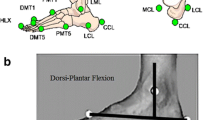Abstract
Static, axial, and rotational deformities of the lower extremities are very frequent in children and often a reason for clinic visits. It is important to make a difference between physiological, usually spontaneously healing conditions, and real pathology. Flatfeet and less frequently cavus feet are the main foot problems. Special attention should be paid to the cavovarus foot that often has an underlying neurological disorder. Localized foot pain has usually a very specific cause and needs further investigation. Genua valga and genua vara are typical for a given age group and correct usually spontaneously. Toeing in and toeing out are mainly cosmetic problems and can be caused by tibial or femoral rotation, very rarely by a foot deformity. Leg length discrepancy is also frequent and in most patients limited to less than 2 cm, causing no further problems. Follow-up is, however, needed because of possible increasing discrepancy during growth.









Similar content being viewed by others
References
Fabry G, Liu XC, Molenaers G (1994) Normal and abnormal torsional development in children. Clin Orthop 302:22–26
Hensinger RN (1986) Standards in pediatric orthopedics. Tables, charts and graphs illustrating growth. Raven, New York
Rao UB, Joseph B (1992) The influence of footwear on the prevalence of flatfoot. A survey of 2300 children. J Bone Joint Surg 74-B:525–527
Samilson RL, Dillin W (1983) Cavus, cavovarus and calcaneocavus. Clin Orthop 177:125–132
Author information
Authors and Affiliations
Corresponding author
Additional information
No benefits or funds were received in support of this study.
Rights and permissions
About this article
Cite this article
Fabry, G. Clinical practice. Eur J Pediatr 169, 529–534 (2010). https://doi.org/10.1007/s00431-009-1122-x
Received:
Accepted:
Published:
Issue Date:
DOI: https://doi.org/10.1007/s00431-009-1122-x




